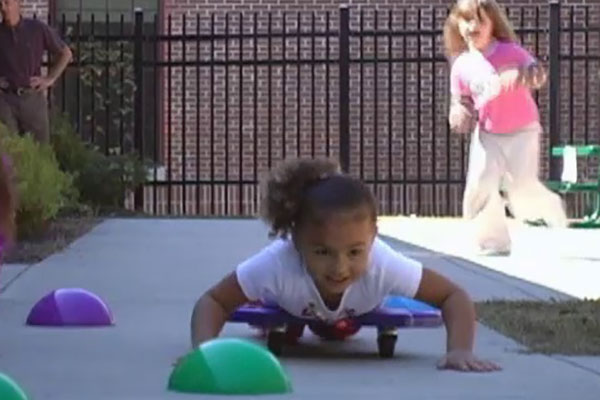Using an Obstacle Course to Promote Active Outdoor Play
(This video has captions. You can turn them on by clicking the CC icon at the bottom of the video.)
Download a printable transcript in English and Spanish.
Narrator: Most preschool children love spending time outside on the playground, and having time to run around outside is important for children’s physical health and development. But research shows that many children don’t use their outdoor time to engage in active behavior.
Narrator: Teachers can do much to encourage children to be more active on the playground for at least part of the time that they’re outside by planning structured physical activities. One way that teachers can engage children in physical play is by planning an outdoor obstacle course with simple, inexpensive equipment. Let’s watch as teacher Niloufar Rezai introduces her preschoolers to a new obstacle course.
Teacher: So we’ll start here, where we’ll jump with two feet. See how I’m jumping? I’m landing on two feet. Ok, we’ll jump all the way around the table, and then we’ll come over here, where we’ll skip.
Narrator: Niloufar takes the time to demonstrate each activity and define terms that may be new to children.
Teacher: We’ll hop and land on one foot – watch.
Teacher: Take off! There he goes, push! You can use your hands, you can use your legs… There he goes!
Narrator: Niloufar gives every child the chance to try each part of the obstacle course during the demonstration.
Teacher: How you doing, Eternity? Use those arms! Big arms, big arms – there she goes!
Teacher: You can hop through from one, the center of one of the hula hoops to the other. You can jump, you can hop, however you want to get there…ok, come all the way around, C’mon.
Teacher: All right, let’s see you do it, come on through. You have to go a little slow sometimes to not touch, but if you do, that’s ok.
Child: I didn’t touch!
Teacher: You didn’t? Ahh!
Child: You touched.
Teacher: Ok, here I go! Alright, you guys try! Come on down. Gallop, gallop, gallop.
Teacher: Back at the beginning. What do you think?
Child: Can we do it again?
Teacher: So, you guys ready to try it on your own?
Child: Yeah.
Teacher: Jumping, skipping, hopping, on the scooter, all the way around. Ok, your turn.
Narrator: The children now have a chance to explore the obstacle course at their own pace. Later, they’ll have plenty of time to engage in unstructured play on the playground.



